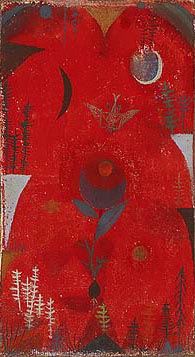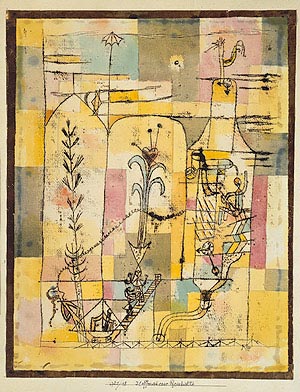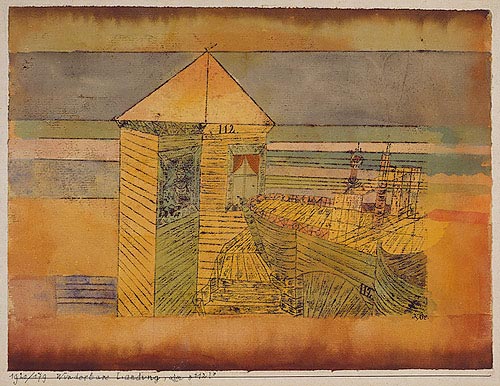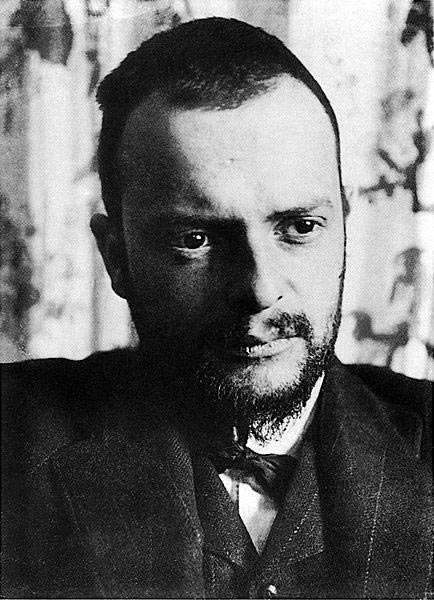| Paul Klee Famous Paintings | |
| Twittering Machine, 1922 | |
| Cat and Bird, 1928 | |
| Senecio, 1922 | |
| Ad Parnassum, 1932 | |
| Castle and Sun, 1928 | |
| Red Balloon, 1922 | |
| Fish Magic, 1925 | |
| Insula Dulcamara, 1938 | |
| Dream City, 1921 | |
| Complete Works |
Paul Klee was a highly individualistic and introspective painter whose style could be considered a combination of expressionism, cubism, and surrealism. He was also a draftsman who was fascinated with color theory, eventually mastering it and writing about the subject matter in various literatures. He taught at the famous German Bauhaus school, which was the epicenter of the art and architecture movement of the same name that gained height and popularity around the early 20th century just before the Second World War
Klee was born on December 18, 1879 in Münchenbuchsee, Switzerland. He was the second of two children in a musically inclined family, with his father being a German music teacher and his mother a trained singer. The young Klee immediately displayed aptitude in music, starting to play the violin at around age seven. At the same time, he seemed to have developed visual prowess as well, being highly engrossed in drawing. However, with what he felt as the restrictive musical milieu during that period, he gravitated more toward the visual arts. As a teenager, Klee had already accomplished substantial skill in landscape drawing.
Paul Klee’s youth is well documented thanks to a journal he kept from around 1897 to 1918, providing valuable accounts and insight into his personal and philosophical thoughts. Klee’s drawing skills and activity continued throughout his school years, occupying himself with caricatures. Apart from interests in art and music, he was also an avid reader. This honed his skills as a writer as well, which would lead to a synthesis of all these interests in the form of art theories he would form later on in his career.
In 1898, he enrolled at the Academy of Fine Arts in Munich, Germany where he continued to excel at drawing but with a seeming handicap in terms of color. With regard to his personal life, Klee reportedly enjoyed a carefree, adventurous young adulthood, spending time in pubs and gallivanting with women. Klee even purportedly sired an illegitimate son in 1900, who unfortunately survived only for several weeks after birth.
 Despite these circumstances, Klee finished a Fine Arts degree and travelled to Italy at the turn of the 20th century where he studied the classical masters in Rome, Florence and Naples. However, he continued to struggle with his longing for improving his works with color. He returned to his parents and continued further art classes, experimenting with various art techniques and zinc-plate etchings. These etchings, dubbed Inventions, were his first exhibited work. He also continued his interest in music by playing the violin in an orchestra, and even writing theater reviews.
Despite these circumstances, Klee finished a Fine Arts degree and travelled to Italy at the turn of the 20th century where he studied the classical masters in Rome, Florence and Naples. However, he continued to struggle with his longing for improving his works with color. He returned to his parents and continued further art classes, experimenting with various art techniques and zinc-plate etchings. These etchings, dubbed Inventions, were his first exhibited work. He also continued his interest in music by playing the violin in an orchestra, and even writing theater reviews.
Klee’s personal life continued to develop as well, with his marriage to Bavarian pianist Lily Stumpf in 1906 and his fathering of a son. The family lived in a Munich suburb, with both parents working in art-related fields while Klee continued to solidify his style and artistic direction. He held his first solo exhibition in 1910. That same year, he also met other artists such as the Russian Wassily Kandinsky and other members of the avant-garde circle. Kandinsky, who would later on become a seminal and pivotal figure in abstract art, served as an inspiration to Klee. With Klee’s association with this group, he seemed to have successfully found the suitable expression of his drawing style with color.
 Traveling to Tunisia in 1914, Klee achieved an artistic epiphany in terms of fascination with light and color, and was converted into abstractionism. Upon returning home, he produced his first completely abstract piece called In the Style of Kairouan. Art scholars describe Klee’s style as musical, not surprisingly due to his background in this field. His color choices are similar to a musical key, sometimes utilizing complementary techniques and then dissonance, which are concepts that are also found in music composition.
Traveling to Tunisia in 1914, Klee achieved an artistic epiphany in terms of fascination with light and color, and was converted into abstractionism. Upon returning home, he produced his first completely abstract piece called In the Style of Kairouan. Art scholars describe Klee’s style as musical, not surprisingly due to his background in this field. His color choices are similar to a musical key, sometimes utilizing complementary techniques and then dissonance, which are concepts that are also found in music composition.
Throughout his life, Klee marked emotional periods with artistic output. During World War I, despite a certain detachment or aloofness, he also produced lithographs that dealt with his distress over the death of some friends in battle. He continued painting despite the war. By 1917, he was enjoying good reputation and popularity among art patrons and critics as well. He even landed a contract with an influential art dealer, enhancing his popularity.
 He began teaching at the Bauhaus academy in 1921, on subjects such as book binding, stained glass, and mural painting. He joined his influential friend Kandinsky at the school and continued his association with the abstractionist’s “The Blue Four” group. He travelled extensively in the United States, Egypt, and exhibited in Paris. He suffered through the start of another war, World War II, but migrated to Switzerland in late 1933. He reached the peak of his career during this period, producing his most identifiable and iconic works such as Ad Parnassum (1932).
He began teaching at the Bauhaus academy in 1921, on subjects such as book binding, stained glass, and mural painting. He joined his influential friend Kandinsky at the school and continued his association with the abstractionist’s “The Blue Four” group. He travelled extensively in the United States, Egypt, and exhibited in Paris. He suffered through the start of another war, World War II, but migrated to Switzerland in late 1933. He reached the peak of his career during this period, producing his most identifiable and iconic works such as Ad Parnassum (1932).
Unforunately, Klee was afflicted with a debilitating autoimmune disease called scleroderma, which was only diagnosed after his death. In 1933, he began suffering from the condition and was stifled creatively. However, he continued to persevere with his art, churning out thousands of works in a year, albeit with simpler compositions and plainer, large color blocks. Paul Klee left behind a body of almost 9,000 artworks upon his death in 1940, all testaments to his highly individualistic and oftentimes child-like, innocent or naïve outlook on life.
